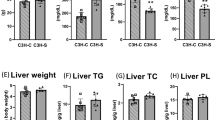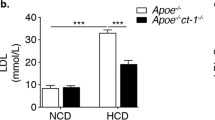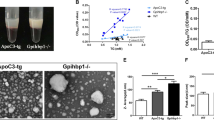Abstract
Increased secretion and levels of ApoB-containing lipoproteins (BLp) commonly occur in familial hyperlipidemia, obesity and diabetes. The plasma phospholipid-transfer protein (PLTP) is known to mediate transfer of phospholipids between BLp and HDL during their intravascular metabolism. To address a possible role of PLTP in dyslipidemia and atherogenesis, we bred mice deficient in the gene encoding PLTP (PLTP-deficient mice) using different hyperlipidemic mouse strains. In ApoB-transgenic and ApoE-deficient backgrounds, PLTP deficiency resulted in reduced production and levels of BLp and markedly decreased atherosclerosis. BLp secretion was diminished in hepatocytes from ApoB-transgenic PLTP-deficient mice, a defect that was corrected when PLTP was reintroduced in adenovirus. The studies reveal a major, unexpected role of PLTP in regulating the secretion of BLp and identify PLTP as a therapeutic target.
This is a preview of subscription content, access via your institution
Access options
Subscribe to this journal
Receive 12 print issues and online access
$209.00 per year
only $17.42 per issue
Buy this article
- Purchase on Springer Link
- Instant access to full article PDF
Prices may be subject to local taxes which are calculated during checkout







Similar content being viewed by others
References
Young, S.G. Recent progress in understanding apolipoprotein B. Circulation 82, 1574–1594 (1990).
Havel, R.J. & Kane, J.P. in The Metabolic Basis of Inherited Disease. (eds. Scriver, C. et al.) 1129–1139 (McGraw–Hill, New York, 1989).
Goldstein, J.L. & Brown, M.S. in The Metabolic Basis of Inherited Disease. (eds. C.R. Scriver et al.) 1215–1225 (McGraw–Hill, New York, 1989).
Kane, J.P. & Havel R.J. in The Metabolic Basis of Inherited Disease. (eds. C.R. Scriver et al.) 1139–1150 (McGraw-Hill, New York, 1989).
Chen, S.H. et al. Apolipoprotein B-48 is the product of a messenger RNA with an organ-specific in-frame stop codon. Science 238, 363–366 (1987).
Powell, L.M. et al. A novel form of tissue-specific RNA processing produces apolipoprotein-B48 in intestine. Cell 50, 831–840 (1987).
Goldstein, J.L. et al. Hyperlipidemia in coronary heart disease. II. Genetic analysis of lipid levels in 176 families and delineation of a new inherited disorder, combined hyperlipidemia. J. Clin. Invest. 52,1544–1568 (1973).
Brunzell, J.D. et al. Plasma lipoproteins in familial combined hyperlipidemia and monogenic familial hypertriglyceridemia. J. Lipid. Res. 24, 147–155 (1983).
Duvillard, L. et al. Metabolic abnormalities of apolipoprotein B-containing lipoproteins in non-insulin-dependent diabetes: a stable isotope kinetic study. Eur. J. Clin. Invest. 30, 685–694 (2000).
Riches, F.M. et al. Hepatic secretion of very-low-density lipoprotein apolipoprotein B-100 studied with a stable isotope technique in men with visceral obesity. Int. J. Obes. Relat. Metab. Disord. 22, 414–423 (1998).
Ginsberg, H.N. Role of lipid synthesis, chaperone proteins and proteasomes in the assembly and secretion of apoprotein B-containing lipoproteins from cultured liver cells. Clin. Exp. Pharmacol. Physiol. 24, A29–32 (1997).
Wetterau, J.R. et al. Absence of microsomal triglyceride transfer protein in individuals with abetalipoproteinemia. Science 258, 999–1001 (1992).
Shoulders, C.C. et al. Abetalipoproteinemia is caused by defects of the gene encoding the 97 kDa subunit of a microsomal triglyceride transfer protein. Hum. Mol. Genet. 2, 2109–2116 (1993).
Havel, R.J., Kane, J.P. & Kashyap, M.L. Interchange of apolipoproteins between chylomicrons and high density lipoproteins during alimentary lipemia in man. J. Clin. Invest. 52, 32–38 (1973).
Jiang, X.-c. et al. Targeted mutation of plasma phospholipid transfer protein gene markedly reduces high-density lipoprotein levels. J. Clin. Invest. 103, 907–914 (1999).
Callow, M.J. Stoltzfus, L.J. Lawn, R.M. & Rubin, E.M. Expression of human apolipoprotein B and assembly of lipoprotein(a) in transgenic mice. Proc. Natl. Acad. Sci. USA 91, 2130–2134 (1994).
Veniant, M.M. et al. Susceptibility to atherosclerosis in mice expressing exclusively apolipoprotein B48 or apolipoprotein B100. J. Clin. Invest. 100, 180–188 (1997).
Mahley, R.W. Apolipoprotein E: cholesterol transport protein with expanding role in cell biology. Science 240, 622–630 (1988).
Plump, A.S. et al. Severe hypercholesterolemia in apolipoprotein E-deficient mice created by homologous recombination in ES cells. Cell 71, 343–353 (1992).
Zhang, S.H. et al. Spontaneous hypercholesterolemia and arterial lesions in mice lacking apolipoprotein E. Science 258, 468–471 (1992).
Plump, A.S. & Breslow, J.L. Apolipoprotein E and the apolipoprotein E-deficient mouse. Annu. Rev. Nutr. 15, 495–518 (1995).
Ishibashi, S. et al. Hypercholesterolemia in low density lipoprotein receptor knockout mice and its reversal by adenovirus-mediated gene delivery. J. Clin. Invest. 92, 883–893 (1992).
Aalto-Setala, K. et al. Mechanism of hypertriglyceridemia in human apoCIII transgenic mice: diminished VLDL fractional catabolic rate associated with increased apoCIII and reduced ApoE on the particles. J. Clin. Invest. 90, 1889–1900 (1992).
Yeung, S.J., Chen, S.H. & Chan, L. Ubiquitin-proteasome pathway mediates intracellular degradation of apolipoprotein B. Biochemistry. 35, 1343–1348 (1996).
Twisk, J. et al. The role of the LDLR in apolipoprotein B secretion. J. Clin. Invest. 105, 521–532 (2000).
Williams, K.J., Brocia, R.W. & Fisher, E.A. The unstirred water layer as a site of control of apolipoprotein B secretion. J. Biol. Chem. 265, 16741–16744 (1990).
Tall, A.R., Abreu, E. & Shuman, J. Seperation of a plasma phospholipid transfer protein from cholesteryl ester/phospholipid exchange protein. J. Biol. Chem. 258, 2174–2180 (1983).
Hamilton, R.L. et al. Chylomicron-sized lipid particles are formed in the setting of apolipoprotein B deficiency. J. Lipid Res. 39, 1543–1557 (1998).
Fang, M., Rivas, M.P. & Bankaitis, V.A. The contribution of lipids and lipid metabolism to cellular functions of the Golgi complex. Biochim. Biophys. Acta. 1404, 85–100 (1998).
Veniant, M.M. et al. Insights into apolipoprotein B biology from transgenic and gene-targeted mice. J. Nutr. 129, 451S–455S (1999).
Wetterau, J.R. et al. An MTP inhibitor that normalizes atherogenic lipoprotein levels in WHHL rabbits. Science 282, 751–754 (1998).
Tall, A.R. Plasma lipid transfer proteins. Annu. Rev. Biochem. 64, 235–257 (1995).
Brown, M.L>. et al. Molecular basis of lipid transfer protein deficiency in a family with increased High-density lipoprotein. Nature 342, 448–451 (1989).
Bruce, C., Beamer, L.J. & Tall, A.R. The implications of the structure of the bactericidal/permeability-increasing protein on the lipid-transfer function of the cholesteryl ester transfer protein. Curr. Opin. Struct. Biol. 8, 426–434 (1998).
Huuskonen. J. et al. Structure and phospholipid transfer activity of human PLTP: analysis by molecular modeling and site-directed mutagenesis. J. Lipid Res. 40, 1123–1130 (1999).
Okamoto, H. et al. A cholesteryl ester transfer protein inhibitor attenuates atherosclerosis in rabbits. Nature 496, 203–206 (2000).
Rinninger, F. et al. Probucol enhances selective uptake of HDL-associated cholesteryl esters in vitro by a scavenger receptor B-I-dependent mechanism. Arterioscler. Thromb. Vasc. Biol. 19, 1325–1332 (1999).
Matthews, C.M.E. The theory of tracer experiments with 131I-labeled plasma proteins. Phys. Med. Biol. 2, 36–53 (1957).
Honkakoski, P. & Negishi, M. Protein serine/threonine phosphatase inhibitors suppress phenobarbital-induced Cyp2b10 gene transcription in mouse primary hepatocytes. Biochem. J. 330, 889–895 (1998).
Li, J. et al. rAAV vector-mediated sarcogylcan gene transfer in a hamster model for limb girdle muscular dystrophy. Gene Ther. 6, 74–82 (1999).
Acknowledgements
This study was supported by NIH grant HL54591.
Author information
Authors and Affiliations
Corresponding author
Rights and permissions
About this article
Cite this article
Jiang, XC., Qin, S., Qiao, C. et al. Apolipoprotein B secretion and atherosclerosis are decreased in mice with phospholipid-transfer protein deficiency. Nat Med 7, 847–852 (2001). https://doi.org/10.1038/89977
Received:
Accepted:
Issue Date:
DOI: https://doi.org/10.1038/89977
This article is cited by
-
Bone marrow mesenchymal stem cellsderived exosomes stabilize atherosclerosis through inhibiting pyroptosis
BMC Cardiovascular Disorders (2023)
-
The Role of Phospholipid Transfer Protein in the Development of Atherosclerosis
Current Atherosclerosis Reports (2021)
-
Plasma angiopoietin-like 4 is related to phospholipid transfer protein activity in diabetic and non-diabetic subjects: role of enhanced low grade inflammation
Lipids in Health and Disease (2018)
-
HDL and atherosclerotic cardiovascular disease: genetic insights into complex biology
Nature Reviews Cardiology (2018)
-
Sphingolipid de novo biosynthesis is essential for intestine cell survival and barrier function
Cell Death & Disease (2018)



